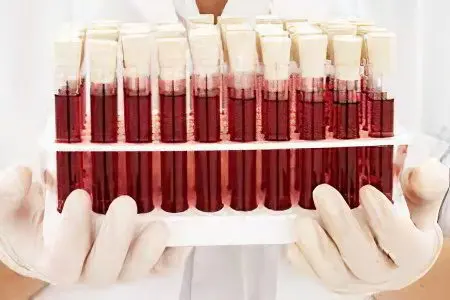Contents
Definition and clinical significance

Total blood protein is one of the indicators of amino acid metabolism in the body, characterizing the concentration of protein molecules of all types and fractions in plasma. It can be said that this indicator of protein metabolism products is a mirror image of the body’s regenerative abilities. After all, proteins play the role of a kind of framework or plastic material on which all other elements of cells and tissues are held. If this substrate is sufficient, any organ or system remains complete, both structurally and functionally.
The entire protein of the human body is represented by more than a hundred different subspecies. These proteins can only consist of an amino acid set, or they can contain various compounds of proteins of different molecular weights with other metabolic products (lipids, carbohydrates, electrolytes in the form of glycoproteins, lipoproteins and hemoglobin, etc.) Their metabolism, especially synthesis, either otherwise occurs in the liver. Therefore, the functional usefulness of this organ is the main regulator of protein metabolism.
The main components of the total protein, which are determined in the course of a biochemical study, are:
Albumins are low molecular weight proteins that provide all the plastic needs of the body for building material to maintain the structure and synthesis of new cells. Make up the bulk of the total protein;
Globulins are large molecular proteins necessary for the synthesis of antibodies, immunoglobulins and other immune proteins (complement components, c-reactive protein, inflammatory mediators, tumor necrosis factor, etc.) In the structure of the total protein, they occupy slightly less than half of the volume;
Fibrinogen is a high molecular weight protein involved in the final stage of the formation of a platelet clot, and is responsible for the usefulness of the blood coagulation system. It accounts for the smallest amount of all components of total protein.
The norm of total protein in the blood
Each of the indicators of a biochemical blood test has its own units of measurement and standard values, with which the results obtained during the study should be compared. The norm of total protein in the blood is in the redistribution 65-85 g / l. Although this value is not constant, the table below shows the norms for women and men, depending on age.
Categories of people | Norm for women | Norm for men |
Newborn | 42-62 g / l | 41-63 g / l |
Children under 1 year old | 44-79 g / l | 47-70 g / l |
Children from 1 to 5 years old | 60-75 g / l | 55-75 g / l |
Children from 5 years old to 8 years old | 53-79 g / l | 52-79 g/l |
Children from 8 years old to 18 years old | 58-77 g / l | 56-79 g / l |
Adults 18-35 years old | 75 — 79 g/l | 82-85 g / l |
Adults 35-60 years old | 79-83 g / l | 76-80 g / l |
Adults 60-75 years old | 74-77 g / l | 76-78 g / l |
Older than 75 years | 69-77 g / l | 73-78 g / l |
The norm of total protein in women
There are no special norms for the indicator of total protein for men and women due to a fairly wide range of upper and lower limits of standard values. But in women, total protein can be reduced by up to 10% compared to men of the same age group. This can be explained by the high needs of the female body in protein, which is spent on the synthesis of sex hormones. The synthetic properties of the liver in women are lower than in men;
The norm of total protein during pregnancy
In pregnant women, fluctuations in total protein are subject to an even greater downward spread. Its decrease to 30% compared with the generally accepted norm can be considered normal and quite natural.
This may be a natural consequence:
Increase in circulating plasma volume due to fluid retention in the vascular space;
Increased needs of the body of a pregnant woman in a plastic material for the synthesis of sex and other hormones of the endocrine glands;
The need for plastic material for the growth and development of the fetus.
Causes of increased total protein in the blood
In the case of an increase in total protein in a biochemical blood test, they speak of hyperproteinemia.
It may indicate:
Dehydration of the body due to pathological loss of fluid or its redistribution between the vascular space and tissues during intoxication, infections and septic conditions;
Enhanced synthesis of antibodies during the formation of immunity after vaccination or past infectious diseases. As a rule, such an increase is not significant;
Myeloma. Such cases of hyperproteinemia are represented by a pronounced increase in protein levels due to pathological proteins (Bence-Jones protein);
DIC-syndrome with hypercoagulability against the background of intoxication and various critical conditions.
Causes of low total protein in the blood

A decrease in the level of total blood protein is called hypoproteinemia. Its presence may indicate the following conditions:
Pathology of the liver, accompanied by hepatocellular insufficiency: viral and toxic hepatitis, cirrhosis of the liver;
Alimentary protein deficiency due to malnutrition and depletion of the body in severe illnesses;
Increased loss of protein in the urine with decompensated kidney pathology and severe proteinuria;
Complications of diabetes;
Chronic severe anemia and massive bleeding;
Diseases of the stomach and intestines with impaired absorption of nutrients;
Enzymatic and secretory insufficiency of the pancreas in chronic pancreatitis;
HIV infection and other immunodeficiencies;
Endocrine pathology in the form of hypothyroidism;
Progression of oncological diseases and their metastasis.









